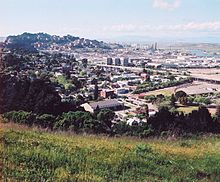Chevron Richmond Refinery

Image showing the refinery and the marshlands in the background; Point Richmond in the foreground.
|
|
| Country | United States |
|---|---|
| City | Richmond, California |
| Coordinates | 37°56′32″N 122°23′43″W / 37.94222°N 122.39528°WCoordinates: 37°56′32″N 122°23′43″W / 37.94222°N 122.39528°W |
| Refinery details | |
| Owner(s) | Chevron Corporation |
| Commissioned | 1902 |
| Capacity | 240,000 bbl/d (38,000 m3/d) |
| No. of employees | 1,200 |
|
|
The Chevron Richmond Refinery is a 2,900-acre (1,200 ha) petroleum refinery in Richmond, California, on San Francisco Bay. It is owned and operated by Chevron Corporation and employs more than 1,200 workers, making it the city's largest employer. The refinery processes approximately 240,000 barrels (38,000 m3) of crude oil a day in the manufacture of petroleum products and other chemicals. The refinery's primary products are motor gasoline, jet fuel, diesel fuel and lubricants. It is also one of the worst industrial offenders for Contra Costa County.
The refinery was established several years before the City of Richmond was incorporated in 1905. Construction on the refinery began in 1901 between the Potrero Hills and the marshlands in the Point Richmond District; the refinery was opened in 1902. The refinery was built by Standard Oil and its first headquarters was in an abandoned farm house at the former site of the Peters and Silva Farms. The complex was described as "colossal" at the time and to this day it remains a very large complex of its kind. In its first year of operation the plant could process 10,000 barrels (1,600 m3) of oil per day and had a tankage capacity of 185,000 barrels (29,400 m3) in that same first year.William Rheem played a key role in the facility's construction and implementation, being the project manager and the installation's first superintendent. Furthermore, Rheem continued on to be a key and historic civic figure in the City of Richmond. The presence of the burgeoning refinery transformed the small town of Richmond from a rural agricultural community with 200 residents to a company town of several thousand within a few years.
The number of passenger cars in the United States rose from 1.6 million to 5.6 million from 1914 to 1918. Motor trucks, farm tractors, and aircraft all increased at a comparable rate. As a result, the demand for gasoline, lubricants and other petroleum products intensified. The Richmond refinery was in an excellent position with its plentiful crude oil, state-of-art equipment and prime location to capitalize on the increased demand for petroleum products on the West Coast. By 1915, the refinery spread across 435 acres (176 ha), employed 1,700 workers, and had a capacity of 60,000 barrels (9,500 m3) a day. Not only did the refinery produce transportation fuels, it also had a grease plant, an asphaltum plant, a can factory, a barrel works, a machine shop and a tank car repair shop.
...
Wikipedia

